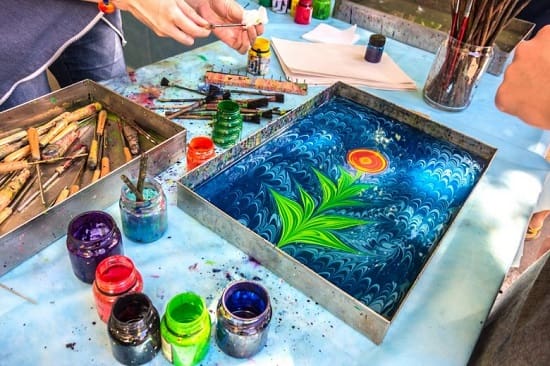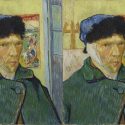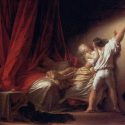What is Ebru Art (Marbling)? How is Ebru art done?
Ebru art, also known as paper marbling or painting on water, is a traditional Turkish art form that dates back to the 15th century.
It involves creating patterns on paper or fabric by floating and manipulating colors on a liquid surface, typically water or a viscous solution of gum tragacanth.
The western name of the marbling paper is Turkish Paper or Turkish Marble Paper. The rumor among the marbling artisans among us is that marbling started in Bukhara. Ebru then comes to Turkiye via the Great Silk Road via Iran, taking the name “Ebri”.
What is Ebru Art?
What are the marbling processes?
The artist first prepares the water or solution with a small amount of thickening agents, such as gum tragacanth, which helps the colors float and spread on the surface without blending too much. The artist then drops different colors of paint onto the surface and manipulates them into patterns using a variety of tools, such as combs, brushes, and styluses.

What is Ebru Art (Marbling) – What materials are used in Ebru Art?
Once the pattern is complete, the artist carefully places a piece of paper or fabric onto the surface to transfer the design. The paper is then carefully lifted off the surface, revealing the marbled design. The process can be repeated with different colors and patterns to create more complex designs.
Ebru art is known for its intricate and colorful designs, which can range from simple patterns to complex motifs that resemble landscapes, flowers, and animals. The art form has also been used to create decorative book covers, endpapers, and calligraphic works.
Ebru art has spread beyond Turkiye and can now be found in various parts of the world, with different regions developing their own styles and techniques. Today, it continues to be practiced and celebrated as a unique and beautiful art form.
There are several marbling processes used in Ebru art, each with its own techniques and unique characteristics.
The following are some of the most common marbling processes used in Ebru:
- Traditional or Turkish Marbling: This is the most well-known and widely practiced marbling technique in Ebru art. It involves creating patterns on a thickened water solution using brushes, combs, and styluses to make various designs. Once the design is complete, the artist places a piece of paper onto the surface, and the pattern is transferred onto the paper.
- Suminagashi Marbling: This is a Japanese marbling technique that involves floating ink on the water to create delicate, fluid designs. Suminagashi typically uses only black ink on white paper, and the designs are often simple and elegant.
- Stone Marbling: This variation of traditional marbling uses specially treated stone to create the designs. The stone is used to apply the pigments and manipulate the patterns on the water surface. Once the design is complete, the paper is placed onto the surface to transfer the pattern.
- Gelgit Marbling: This is a variation of traditional marbling that involves using a specially prepared viscous solution of gum tragacanth or carrageenan. The solution allows for more precise control over the placement of the colors and the resulting patterns.
- Oil Marbling: This is a marbling technique that uses oil-based pigments instead of water-based pigments. The pigments are floated on a surface of water mixed with a surfactant, such as soap or detergent. Once the design is complete, the paper is placed onto the surface, and the pattern is transferred.
Overall, each marbling process in Ebru art requires a different set of skills and techniques, and the resulting patterns and designs can vary widely.
Ebru artists often experiment with different processes and materials to create unique and beautiful works of art.
What materials are used in Ebru?
The materials used in Ebru, or paper marbling, can vary depending on the specific technique and style used. However, the following are the most common materials used in Ebru art:
- Water: Water is the primary medium used in Ebru. The artist uses water as a base for floating the paints and creating patterns.
- Pigments: Ebru artists use pigments to create colorful designs transferred onto paper or fabric. The pigments used in Ebru are usually water-based and can be mixed with water to create a variety of colors.
- Thickeners: Thickeners, such as gum tragacanth or carrageenan, are added to the water to create a viscous solution that helps the paints float on the surface without blending too much.
- Brushes, combs, styluses: Artists use a variety of tools, such as brushes, combs, and styluses, to manipulate the paints and create patterns on the surface of the water.
- Paper or fabric: The final design is transferred onto a piece of paper or fabric. Different types of paper or fabric can be used depending on the desired effect, such as smooth or textured surfaces.
- Chemicals: Chemicals, such as alum, can be added to the water to prepare the surface for the transfer of the design onto the paper or fabric.
Overall, Ebru is a relatively simple art form that requires only a few basic materials, but the skill and technique required to create beautiful and intricate designs take years of practice and experimentation.

What is Ebru Art (Marbling)? – What materials are used in Ebru?
What are the types of ebru art (marbling art)?
Ebru art (Marbling art, or paper marbling) is a versatile art form that can take many different forms, depending on the materials and techniques used. Here are some of the most common types of marbling art:
- Traditional or Turkish Marbling: This is the most widely known and practiced form of marbling art. It involves creating intricate patterns on a thickened water solution using brushes, combs, and styluses to make various designs. Once the design is complete, the artist places a piece of paper onto the surface, and the pattern is transferred onto the paper.
- Suminagashi Marbling: This is a Japanese marbling technique that involves floating ink on the water to create delicate, fluid designs. Suminagashi typically uses only black ink on white paper, and the designs are often simple and elegant.
- Ebru Ab-ı Zere: This is a Turkish marbling technique that involves adding a small amount of oil to the surface of the water, which creates more detailed and intricate patterns.
- Stone Marbling: This variation of traditional marbling uses specially treated stone to apply the pigments and manipulate the patterns on the water surface.
- Oil Marbling: This is a marbling technique that uses oil-based pigments instead of water-based pigments. The pigments are floated on a surface of water mixed with a surfactant, such as soap or detergent.
- Acrylic Marbling: This is a modern variation of marbling that uses acrylic paints and a variety of other techniques and materials to create abstract, colorful designs.
- Shaving Cream Marbling: This is a simple and fun form of marbling that uses shaving cream mixed with food coloring or liquid watercolors to create swirls and patterns.
Overall, ebru art (marbling art) can take many different forms, and artists often experiment with different techniques and materials to create unique and beautiful works of art.

Suminagashi (Japanese marbling technique), is one example of marbling art. – What is Ebru Art (Marbling)? – What were the paints used for marbling produced from?

The God-Written Marbling Work of Necmeddin Okyay – A Written Ebru – The Art of Ebru
What were the paints used for marbling produced from?
The paints used for marbling, or paper marbling, can be made from a variety of natural and synthetic pigments.
Historically, marbling artists would often use natural pigments, such as those made from minerals, plants, and even insects. These pigments were typically ground into a fine powder and mixed with water or other liquids to create paint.

What is Ebru Art (Marbling)? – What were the paints used for marbling produced from?
In modern times, synthetic pigments are more commonly used for marbling paints. These pigments are made from various chemical compounds and are often formulated to be water-soluble, which is necessary for creating the designs on the water surface.
The specific pigments used for marbling can vary depending on the desired effect, as well as the availability and preference of the artist. Some common pigments used in marbling include:
- Iron oxide (red ochre, yellow ochre): a natural pigment made from iron oxide that creates earthy colors such as red and yellow.
- Ultramarine: a synthetic blue pigment made from a chemical compound that creates a rich, deep blue.
- Chrome yellow: a synthetic yellow pigment made from lead chromate that creates a bright, sunny yellow.
- Vermilion: a synthetic red pigment made from mercuric sulfide that creates a bright, fiery red.
- Indigo: a natural blue pigment made from the indigo plant that creates a range of blue shades, from light to dark.
Overall, the paints used for marbling can come from a wide range of sources, both natural and synthetic, and the choice of pigments can have a significant impact on the final appearance of the marbled designs.
Recommended For You – Allegories and Symbols in Paintings
Resources:
- https://www.zingat.com/blog/ebru-sanati-ile-evinizi-renklendirin/ (Görsel)
- https://www.arkhesanat.com/ebru-sanatinin-nasil-yapildigini-ogrenmek-ister-misiniz/ (Görsel)
- https://20160902018blog.wordpress.com/ebru-ornekleri/281-2/ (Görsel)
- Mustafa Düzgünman’ın Ebru Sanatından Bir Örnek (Öne Çıkan Görsel)
- https://chat.openai.com/
- https://mymodernmet.com/what-is-ebru-art-definition/
- https://www.toa.st/blogs/magazine/suminagashi-marbling-with-natalie-stopka









Good content. Thank you.
Thanks Alain.
Your style is so unique compared to other people I have read stuff from. I appreciate you for posting when you have the
opportunity, I guess I will just bookmark this site. Thank you.
Thank you.